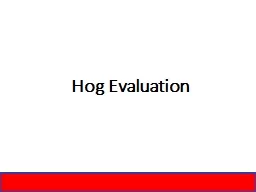

PARTS Crest Blade Forearm Knee Pastern Dewclaw Sheath Flank Hock Hip Loin Top Ham Elbow Pock et Stifle x HamLoin Junction Cannon Jaw lineJowl Ear Notching Breeds Maternal ID: 544054
Download Presentation The PPT/PDF document "Hog Evaluation" is the property of its rightful owner. Permission is granted to download and print the materials on this web site for personal, non-commercial use only, and to display it on your personal computer provided you do not modify the materials and that you retain all copyright notices contained in the materials. By downloading content from our website, you accept the terms of this agreement.
Slide1
Hog EvaluationSlide2
PARTS
Crest
Blade
Forearm
Knee
Pastern
Dewclaw
Sheath
Flank
Hock
Hip
Loin
Top
Ham
Elbow Pock
et
Stifle
x
Ham-Loin Junction
Cannon
Jaw line/JowlSlide3
Ear NotchingSlide4
Breeds- Maternal
Chester
White (No other pigmentation)
Down ears (about medium size)Mothering ability, durability and superior musclingLandraceAll whiteLarge down earsProlific, superior mothering abilityYorkshireAll white, with erect earsDurable mothers that offer longevityAlso produce carcass meritSlide5
Breeds- Terminal
Duroc
Reddish brown
Down earsGrowth (feed conversion), carcass qualityHampshireBlack, with a white belt (belt can be broken)Carcass qualitiesSlide6
Breeds-Terminal
Spot
Black and white
No red or brown tinge hairDown earsSpotted patternFast growing, feed efficiency, carcass qualityBerkshireBlack with six white pointsExcellent carcass qualityPoland ChinaBlack with 6 white pointsMedium size down earsLarge size, pork productionSlide7
Market Hog Selection Criteria
Muscle
Optimal Leanness Production
Orientation/WeightSkeletal width and dimensionGain abilitySkeletal CorrectnessBalance and DesignSlide8
Product Merit
Areas to examine muscle: (front to back)
Forearm
Behind the bladesLoinHam-Loin JunctionHipHamStifleBase WidthSlide9
Insert 2 pictures of heavy muscled hogs
Forearm
Backside of their blades
Hip
Stifle
Lower Ham
LoinSlide10
Muscle Comparison
Squarer turn to his loin edge, stouter hipped and more natural dimension thru his ham
Less shapely, plain topped, flatter and less descript in his view from behindSlide11
Muscle Comparison
More powerful forearm, bolder bladed, more expressive thru her stifle and lower ham
Fragile fore arm, flat bladed, very modest in her overall muscle contentSlide12
Muscle Comparison
Narrower Loin
Thicker Loin
Narrower based
Flatten and tapper down through his lower ham**Appears leanerWider and fuller though his lower ham**Appears fatterSlide13
Product Merit
Areas to examine leanness
Jaw line (Jowl)BladesFore RibsLoin EdgeLower third of the body
Seam of hamSlide14
Lean vs. Fat Hogs
Wt = 247 lbs
Wt = 252 lbsSlide15
Optimal Leanness
Selection has shifted from picking the leanest and rawest designed market hogs to those with more production and in turn finish.
Judges are selecting
hogs with more cover because typically those hogs are easier growing, more productive in their rib design, and sounder. *Note: Hogs must have muscle and an acceptable lean gain to be profitable. *Note: Market hogs must have at least 0.6 of fat for bacon productionSlide16
Unacceptable
Early 1990’s
Acceptable
TodaySlide17
Production
The trait most heavily selected for by the industry is
productionDefinition:
Easy-growing, wide skeleton hogs that are designed with more center body dimension and a more practical look from the side.Slide18
Growth Curve
More skeletally extended, later maturing, longer
face
, longer fronted, taller shouldered, longer
spined
Early Maturing, Short Bodied and Compact, Low FrontedSlide19
Structure
Obvious points:
Proper angle and cushion to their shoulder, knee, hock and pastern
Hip design – length and levelness Tail SetSpecific details:Uniformity of toeFoot size Heaviness of skeletonSlide20
Skeletally CorrectSlide21
Skeletal IssuesSlide22
Side View of Rear LegSlide23
Side View of Front LegSlide24
Front Legs Rear LegsSlide25
Balance
If a hog is proportional and all parts fit together in an organized fashion
Balanced
Poor BalanceSlide26
Carcass TerminologySlide27
Cutability
Cutability
is based on the percentage of muscle of the bone-in 4 lean cuts:
HamLoinPicnic ShoulderBoston ButtSlide28Slide29
Breeding Hog Criteria's
Soundness
-Structural CorrectnessBody
-Skeletal Width and VolumePerformanceBalance/Design/Femininity(or Ruggedness) MuscleUnderline QualityFunctional Sheath (Penis)VulvaTesticlesSlide30
Breeding Gilts
Big Bodied and Maternal
Sound and Durable
Correct size and shape to vulvaHigh counting, refined and evenly spaced underline